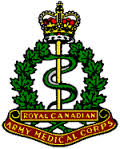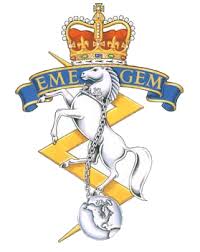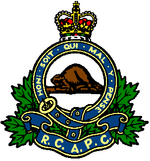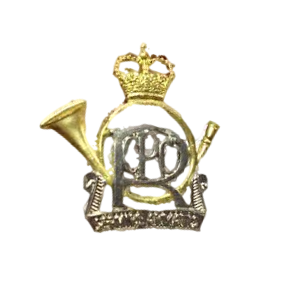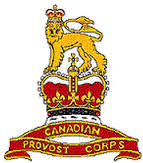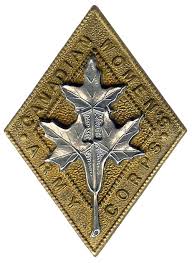Royal Canadian Corps of Signals (RCC Sigs)
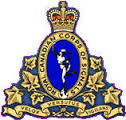 In August 1911 a Special Course of Training was held at Petawawa which evolved in 1912 into a School of Signalling. With the war clouds from the “German menace” looming in Europe, Canada’s signalmen were being groomed for their role in the upcoming war.
In August 1911 a Special Course of Training was held at Petawawa which evolved in 1912 into a School of Signalling. With the war clouds from the “German menace” looming in Europe, Canada’s signalmen were being groomed for their role in the upcoming war.
In 1913 General Order 96 detailed a major reorganization for the new Signalling Corps in anticipation of war in Europe.
In June 1913, General Order 98 redesignated the Signalling Corps as the “Canadian Signal Corps” (CSC). The authorized establishment was 18 officers and 276 men in four companies of three sections each. For the first time a war time role, to provide brigade signal sections for mobilized divisions, was assigned. All other formation signalling was still to be done by the Canadian Engineers Signalling Service. Click here to learn more about the RCC Sigs.
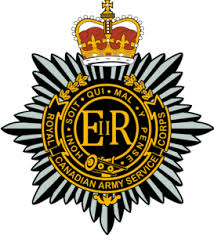 Royal Canadian Army Service Corps (RCASC)
Royal Canadian Army Service Corps (RCASC)
The RCASC was an administrative and transport corps of the Canadian Army. The Canadian Army Service Corps was established in the Non-Permanent Active Militia in 1901, and in the Permanent Active Militia in 1903. The Canadian Permanent Army Service Corps was redesignated The Royal Canadian Army Service Corps on 3 Nov 1919. Click here to learn more about the RCASC.
Royal Canadian Ordnance Corps (RCOC)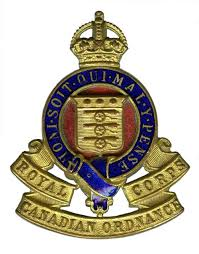
The RCOC was an administrative corps of the Canadian Army. The Royal Canadian Ordnance Corps RCOC can trace its roots back to the Canadian Stores Department. Formed in 1871, the Canadian Stores Department was a civil department of the Canadian Government. This civil service was charged with control of forts, ammunition, stores, buildings and an ordnance depot left by the departing British Military. Click here to learn more about the RCOC.
 Royal Canadian Army Medical Corps (RCAMC)
Royal Canadian Army Medical Corps (RCAMC)
The RCAMC evolved from Militia Medical Service was established in 1899. The Militia Medical Service was redesignated as a Corps on 2 July, 1904; the regular component as “Permanent Active Militia Medical Corps” and the militia component as “Militia Army Medical Corps in 1904.Both components were redesignated “Canadian Army Medical Corps” on 1 May, 1909. The regular component was redesignated “The Royal Canadian Army Medical Corps” on 3 November, 1919; the militia component “Royal Canadian Army Medical Corps” on 29 April, 1936. The two elements were finally united under one name on 22 March, 1948 as “The Royal Canadian Army Medical Corps”. Click here to learn more about the RCAMC.
Corps of Royal Canadian Electrical and Mechanical Engineers (RCEME)
The RCEME was provided army engineering maintenance support. From the 1980s to 2013 it was called the Electrical and Mechanical Engineering Branch. Click here to learn more about the RCEME.
 Royal Canadian Army Pay Corps (RCAPC)
Royal Canadian Army Pay Corps (RCAPC)
The RCAPC was an administrative corps of the Canadian Army with its own cap badge, and other insignia and traditions. It was established in 1906 as the Canadian Army Pay Corps. It was responsible for administering all financial matters. Click here to learn more about the RCAPC
Royal Canadian Army Postal Corps (RCPC)
The RCPC was an administrative corps of the Canadian Army. The Canadian Postal Corps was redesignated The Royal Canadian Postal Corps on 20 June, 1961.[2] The badge of The Royal Canadian Postal Corps consists of a horn, with a Queen’s Crown on top. Superimposed at the center of the horn is the text RCPC. At the bottom the text “Servire Armatis” is written on a ribbon. Click here to learn more about the RCPC.
 Canadian Army Provost Corps (C Pro C)
Canadian Army Provost Corps (C Pro C)
CProC provided traffic control, field security, investigation and detention services for both military offenders and prisoners of war during WWI, WWII and Korea. Click here to learn more about the C Pro C
Canadian Womens Army Corps (CWAC)
The CAWC was a non-combatant branch of the Canadian Army for women established during the Second World War to release men from those non-combatant roles in the Canadian armed forces as part of expanding Canada’s war effort. Most women served in Canada but some served overseas, most in roles such as secretaries, mechanics, cooks and so on. The CWAC was finally abolished as a separate corps in 1964 when women were fully integrated into the Canadian armed forces. Click here to learn more about the CWAC.

